Zircon U-Pb Ages, Petrogenesis, and Tectono-Magmatic Evolution of Late Jurassic–Early Cretaceous S-Type Granitoid in Wujinshan Area of Northwestern Zhejiang, South China
Abstract
:1. Introduction
2. Regional Geological Background
3. Local Geological Features of the Wujinshan Area
3.1. Stratigraphy
3.2. Structure
3.3. Igneous Rocks
3.4. Petrography of Wujinshan Granites
4. Materials and Methods
4.1. Zircon U-Pb Dating
4.2. Major and Trace Element Analyses
4.3. Sr-Nd Isotopic Analyses
5. Results
5.1. Zircon U-Pb Ages
5.2. Major and Trace Elements
5.3. Bulk-Rock Sr-Nd Isotopes
6. Discussion
6.1. Timing of Magmatism
6.2. Petrogenesis
6.2.1. Petrogenetic Classification of Wujinshan Granite
6.2.2. Potential Magma Source for Wujinshan S-Type Granites
6.3. Tectono-Magmatic Dynamics for Wujinshan S-Type Granitoid
6.4. Hydrothermal Alterations
7. Conclusions
Author Contributions
Funding
Data Availability Statement
Acknowledgments
Conflicts of Interest
Correction Statement
References
- Lee, C.-T.A.; Luffi, P.; Plank, T.; Dalton, H.; Leeman, W.P. Constraints on the depths and temperatures of basaltic magma generation on Earth and other terrestrial planets using new thermobarometers for mafic magmas. Earth Planet. Sci. Lett. 2009, 279, 20–33. [Google Scholar] [CrossRef]
- Xiao, W.; Santosh, M. The western Central Asian Orogenic Belt: A window to accretionary orogenesis and continental growth. Gondwana Res. 2014, 25, 1429–1444. [Google Scholar] [CrossRef]
- Xiong, X.; Zhu, L.; Zhang, G.; Li, N.; Yuan, H.; Ding, L.; Sun, C.; Guo, A. Fluid inclusion geochemistry and magmatic oxygen fugacity of the Wenquan Triassic molybdenum deposit in the Western Qinling Orogen, China. Ore Geol. Rev. 2018, 99, 244–263. [Google Scholar] [CrossRef]
- Yamanoi, M.; Maia, J.M. Analysis of rheological properties of fiber suspensions in a Newtonian fluid by direct fiber simulation. Part 3: Behavior in uniaxial extensional flows. J. Nonnewton. Fluid. Mech. 2010, 165, 1682–1687. [Google Scholar] [CrossRef]
- Xinmin, Z.; Tao, S.; Weizhou, S.; Liangshu, S.; Yaoling, N. Petrogenesis of Mesozoic granitoids and volcanic rocks in South China: A response to tectonic evolution. Episodes 2006, 29, 26–33. [Google Scholar] [CrossRef]
- Li, X.-H.; Li, W.-X.; Wang, X.-C.; Li, Q.-L.; Liu, Y.; Tang, G.-Q.; Gao, Y.-Y.; Wu, F.-Y. SIMS U–Pb zircon geochronology of porphyry Cu–Au–(Mo) deposits in the Yangtze River Metallogenic Belt, eastern China: Magmatic response to early Cretaceous lithospheric extension. Lithos 2010, 119, 427–438. [Google Scholar] [CrossRef]
- Pan, Y.; Dong, P. The Lower Changjiang (Yangzi/Yangtze River) metallogenic belt, east central China: Intrusion- and wall rock-hosted Cu–Fe–Au, Mo, Zn, Pb, Ag deposits. Ore Geol. Rev. 1999, 15, 177–242. [Google Scholar] [CrossRef]
- Zheng, Y.-F.; Xiao, W.-J.; Zhao, G. Introduction to tectonics of China. Gondwana Res. 2013, 23, 1189–1206. [Google Scholar] [CrossRef]
- Wang, Y.; Fan, W.; Zhang, G.; Zhang, Y. Phanerozoic tectonics of the South China Block: Key observations and controversies. Gondwana Res. 2013, 23, 1273–1305. [Google Scholar] [CrossRef]
- Li, Z.X.; Li, X.H.; Kinny, P.D.; Wang, J. The breakup of Rodinia: Did it start with a mantle plume beneath South China? Earth Planet. Sci. Lett. 1999, 173, 171–181. [Google Scholar] [CrossRef]
- Santosh, M.; Maruyama, S.; Yamamoto, S. The making and breaking of supercontinents: Some speculations based on superplumes, super downwelling and the role of tectosphere. Gondwana Res. 2009, 15, 324–341. [Google Scholar] [CrossRef]
- Su, W.; Huff, W.D.; Ettensohn, F.R.; Liu, X.; Zhang, J.e.; Li, Z. K-bentonite, black-shale and flysch successions at the Ordovician–Silurian transition, South China: Possible sedimentary responses to the accretion of Cathaysia to the Yangtze Block and its implications for the evolution of Gondwana. Gondwana Res. 2009, 15, 111–130. [Google Scholar] [CrossRef]
- Chen, J.; Jahn, B.-M. Crustal evolution of southeastern China: Nd and Sr isotopic evidence. Tectonophysics 1998, 284, 101–133. [Google Scholar] [CrossRef]
- Li, X.-h.; Li, Z.-X.; Zhou, H.; Liu, Y.; Kinny, P.D. U–Pb zircon geochronology, geochemistry and Nd isotopic study of Neoproterozoic bimodal volcanic rocks in the Kangdian Rift of South China: Implications for the initial rifting of Rodinia. Precambrian Res. 2002, 113, 135–154. [Google Scholar] [CrossRef]
- Zhao, G. Jiangnan Orogen in South China: Developing from divergent double subduction. Gondwana Res. 2015, 27, 1173–1180. [Google Scholar] [CrossRef]
- Gao, P.; Zheng, Y.-F.; Zhao, Z.-F. Triassic granites in South China: A geochemical perspective on their characteristics, petrogenesis, and tectonic significance. Earth Sci. Rev. 2017, 173, 266–294. [Google Scholar] [CrossRef]
- Zhao, G.; Cawood, P.A. Precambrian geology of China. Precambr. Res. 2012, 222–223, 13–54. [Google Scholar] [CrossRef]
- Faure, M.; Chen, Y.; Feng, Z.; Shu, L.; Xu, Z. Tectonics and geodynamics of South China: An introductory note. J. Asian Earth Sci. 2017, 141, 1–6. [Google Scholar] [CrossRef]
- Wang, Y.; Zhang, A.; Fan, W.; Zhao, G.; Zhang, G.; Zhang, Y.; Zhang, F.; Li, S. Kwangsian crustal anatexis within the eastern South China Block: Geochemical, zircon U–Pb geochronological and Hf isotopic fingerprints from the gneissoid granites of Wugong and Wuyi–Yunkai Domains. Lithos 2011, 127, 239–260. [Google Scholar] [CrossRef]
- Shu, L.; Wang, B.; Cawood, P.A.; Santosh, M.; Xu, Z. Early Paleozoic and Early Mesozoic intraplate tectonic and magmatic events in the Cathaysia Block, South China. Tectonics 2015, 34, 1600–1621. [Google Scholar] [CrossRef]
- Wang, Q.; Zhao, Z.H.; Jian, P.; Xiong, X.L.; Bao, Z.W.; Dai, T.M.; Xu, J.F.; Ma, J.L. Geochronology of Cretaceous A-type granitoids or alkaline intrusive rocks in the hinterland, South China: Constraints for late-Mesozoic tectonic evolution. Acta Petrol. Sin. 2005, 21, 795–808. [Google Scholar]
- Mao, J.; Ye, H.; Liu, K.; Li, Z.; Takahashi, Y.; Zhao, X.; Kee, W.-S. The Indosinian collision–extension event between the South China Block and the Palaeo-Pacific plate: Evidence from Indosinian alkaline granitic rocks in Dashuang, eastern Zhejiang, South China. Lithos 2013, 172–173, 81–97. [Google Scholar] [CrossRef]
- Wang, K.-X.; Sun, T.; Chen, P.-R.; Ling, H.-F.; Xiang, T.-F. The geochronological and geochemical constraints on the petrogenesis of the Early Mesozoic A-type granite and diabase in northwestern Fujian province. Lithos 2013, 179, 364–381. [Google Scholar] [CrossRef]
- Dai, B.-Z.; Jiang, S.-Y.; Jiang, Y.-H.; Zhao, K.-D.; Liu, D.-Y. Geochronology, geochemistry and Hf–Sr–Nd isotopic compositions of Huziyan mafic xenoliths, southern Hunan Province, South China: Petrogenesis and implications for lower crust evolution. Lithos 2008, 102, 65–87. [Google Scholar] [CrossRef]
- Xu, H.; Ma, C.; Zhao, J.; Zhang, J. Magma Mixing Generated Triassic I-Type Granites in South China. J. Geol. 2014, 122, 329–351. [Google Scholar] [CrossRef]
- Li, Z.; Zhou, J.; Mao, J.; Santosh, M.; Yu, M.; Li, Y.; Hu, Y.; Langmuir, C.H.; Chen, Z.; Cai, X.; et al. Zircon U–Pb geochronology and geochemistry of two episodes of granitoids from the northwestern Zhejiang Province, SE China: Implication for magmatic evolution and tectonic transition. Lithos 2013, 179, 334–352. [Google Scholar] [CrossRef]
- Xia, Y.; Xu, X.; Liu, L. Transition from adakitic to bimodal magmatism induced by the paleo-Pacific plate subduction and slab rollback beneath SE China: Evidence from petrogenesis and tectonic setting of the dike swarms. Lithos 2016, 244, 182–204. [Google Scholar] [CrossRef]
- Suo, Y.; Li, S.; Jin, C.; Zhang, Y.; Zhou, J.; Li, X.; Wang, P.; Liu, Z.; Wang, X.; Somerville, I. Eastward tectonic migration and transition of the Jurassic-Cretaceous Andean-type continental margin along Southeast China. Earth Sci. Rev. 2019, 196, 102884. [Google Scholar] [CrossRef]
- Black, L.P.; Kamo, S.L.; Allen, C.M.; Aleinikoff, J.N.; Davis, D.W.; Korsch, R.J.; Foudoulis, C. TEMORA 1: A new zircon standard for Phanerozoic U–Pb geochronology. Chem. Geol. 2003, 200, 155–170. [Google Scholar] [CrossRef]
- Liang, Q.; Jing, H.; Gregoire, D.C. Determination of trace elements in granites by inductively coupled plasma mass spectrometry. Talanta 2000, 51, 507–513. [Google Scholar] [CrossRef]
- Miyazaki, T.; Shuto, K. Sr and Nd isotope ratios of twelve GSJ rock reference samples. Geochem. 1998, 32, 345–350. [Google Scholar] [CrossRef]
- Middlemost, E.A.K. Naming materials in the magma/igneous rock system. Earth Sci. Rev. 1994, 37, 215–224. [Google Scholar] [CrossRef]
- Peccerillo, A.; Taylor, S.R. Geochemistry of eocene calc-alkaline volcanic rocks from the Kastamonu area, Northern Turkey. Contrib. Mineral. Petrol. 1976, 58, 63–81. [Google Scholar] [CrossRef]
- Sun, S.S.; McDonough, W.F. Chemical and isotopic systematics of oceanic basalts: Implications for mantle composition and processes. Geol. Soc. Lond. 1989, 42, 313–345. [Google Scholar] [CrossRef]
- Maniar, P.D.; Piccoli, P.M. Tectonic discrimination of granitoids. GSA Bulletin 1989, 101, 635–643. [Google Scholar] [CrossRef]
- Frost, B.R.; Barnes, C.G.; Collins, W.J.; Arculus, R.J.; Ellis, D.J.; Frost, C.D. A Geochemical Classification for Granitic Rocks. J. Petrol. 2001, 42, 2033–2048. [Google Scholar] [CrossRef]
- Gill, R.; Fitton, G. Igneous Rocks and Processes: A Practical Guide; John Wiley & Sons: Hoboken, NJ, USA, 2022. [Google Scholar]
- Zhu, Y.-D.; Zhang, D.-H.; Wang, L.-L.; Dai, Y.-P.; Xi, A.-H. Petrogenesis and metallogenic potential of the Jurassic porphyries in the northwest Zhejiang Province, South China: Insights from SHRIMP zircon geochronology, geochemistry, and Sr–Nd–Hf isotopes of the Huangbaikeng ore-bearing porphyries. Int. Geol. Rev. 2017, 59, 219–233. [Google Scholar] [CrossRef]
- Song, G.; Qin, K.; Li, G.; Liu, T.; Li, J.; Li, X.; Chang, Z. Geochronologic and isotope geochemical constraints on magmatism and associated W–Mo mineralization of the Jitoushan W–Mo deposit, middle–lower Yangtze Valley. Int. Geol. Rev. 2012, 54, 1532–1547. [Google Scholar] [CrossRef]
- Mao, Z.; Cheng, Y.; Liu, J.; Yuan, S.; Wu, S.; Xiang, X.; Luo, X. Geology and molybdenite Re–Os age of the Dahutang granite-related veinlets-disseminated tungsten ore field in the Jiangxin Province, China. Ore Geol. Rev. 2013, 53, 422–433. [Google Scholar] [CrossRef]
- Mao, Z.-H.; Liu, J.-J.; Mao, J.-W.; Deng, J.; Zhang, F.; Meng, X.-Y.; Xiong, B.-K.; Xiang, X.-K.; Luo, X.-H. Geochronology and geochemistry of granitoids related to the giant Dahutang tungsten deposit, middle Yangtze River region, China: Implications for petrogenesis, geodynamic setting, and mineralization. Gondwana Res. 2015, 28, 816–836. [Google Scholar] [CrossRef]
- Tang, Y.; Li, X.; Xie, Y.; Liu, L.; Lan, T.; Meffre, S.; Huang, C. Geochronology and geochemistry of late Jurassic adakitic intrusions and associated porphyry Mo–Cu deposit in the Tongcun area, east China: Implications for metallogenesis and tectonic setting. Ore Geol. Rev. 2017, 80, 289–308. [Google Scholar] [CrossRef]
- Wong, J.; Sun, M.; Xing, G.; Li, X.-H.; Zhao, G.; Wong, K.; Yuan, C.; Xia, X.; Li, L.; Wu, F. Geochemical and zircon U–Pb and Hf isotopic study of the Baijuhuajian metaluminous A-type granite: Extension at 125–100 Ma and its tectonic significance for South China. Lithos 2009, 112, 289–305. [Google Scholar] [CrossRef]
- Wang, Y.-B.; Zeng, Q.-D.; Zhang, S.; Chen, P.-W.; Gao, S. Spatial-temporal relationships of late Mesozoic granitoids in Zhejiang Province, Southeast China: Constraints on tectonic evolution. Int. Geol. Rev. 2018, 60, 1529–1559. [Google Scholar] [CrossRef]
- Yang, Y.; Shi, Y.; Anderson, J.L. Zircon SHRIMP U-Pb ages and geochemistry of Late Mesozoic granitoids in Western Zhejiang and Southern Anhui: Constraints on the model of lithospheric thinning of Southeast China. Int. Geol. Rev. 2018, 60, 1594–1620. [Google Scholar] [CrossRef]
- Zhou, J.; Jin, C.; Suo, Y.; Li, S.; Zhang, L.; Liu, Y.; Wang, G.; Wang, P.; Dai, L.; Santosh, M. Yanshanian mineralization and geodynamic evolution in the Western Pacific Margin: A review of metal deposits of Zhejiang Province, China. Ore Geol. Rev. 2021, 135, 104216. [Google Scholar] [CrossRef]
- Zhou, J.; Jin, C.; Suo, Y.; Li, S.; Zhang, L.; Liu, Y.; Wang, G.; Wang, P.; Dai, L.; Santosh, M. The Yanshanian (Mesozoic) metallogenesis in China linked to crust-mantle interaction in the western Pacific margin: An overview from the Zhejiang Province. Gondwana Res. 2022, 102, 95–132. [Google Scholar] [CrossRef]
- de Saint Blanquat, M.; Horsman, E.; Habert, G.; Morgan, S.; Vanderhaeghe, O.; Law, R.; Tikoff, B. Multiscale magmatic cyclicity, duration of pluton construction, and the paradoxical relationship between tectonism and plutonism in continental arcs. Tectonophysics 2011, 500, 20–33. [Google Scholar] [CrossRef]
- Zhu, Y.; Zhang, D.; Wang, L.; Dai, Y.; Xi, A. SHRIMP zircon UPb dating, geochemistry and SrNdHf isotopes of the Tongcun ore-bearing porphyry in NW Zhejiang Province, South China. J. Geochem. Explor. 2017, 172, 50–61. [Google Scholar] [CrossRef]
- Li, W.-X.; Li, X.-H.; Li, Z.-X.; Lou, F.-S. Obduction-type granites within the NE Jiangxi Ophiolite: Implications for the final amalgamation between the Yangtze and Cathaysia Blocks. Gondwana Res. 2008, 13, 288–301. [Google Scholar] [CrossRef]
- Charvet, J.; Shu, L.; Faure, M.; Choulet, F.; Wang, B.; Lu, H.; Breton, N.L. Structural development of the Lower Paleozoic belt of South China: Genesis of an intracontinental orogen. J. Asian Earth Sci. 2010, 39, 309–330. [Google Scholar] [CrossRef]
- Chappell, B.W.; White, A.J.R. I-and S-type granites in the Lachlan Fold Belt. Earth Environ. Sci. Trans. R. Soc. Edinb. 1992, 83, 1–26. [Google Scholar]
- Liu, L.; Hu, R.-Z.; Zhong, H.; Yang, J.-H.; Kang, L.-F.; Zhang, X.-C.; Fu, Y.-Z.; Mao, W.; Tang, Y.-W. Petrogenesis of multistage S-type granites from the Malay Peninsula in the Southeast Asian tin belt and their relationship to Tethyan evolution. Gondwana Res. 2020, 84, 20–37. [Google Scholar] [CrossRef]
- Clemens, J.D.; Stevens, G. What controls chemical variation in granitic magmas? Lithos 2012, 134–135, 317–329. [Google Scholar] [CrossRef]
- Chappell, B.W. Aluminium saturation in I- and S-type granites and the characterization of fractionated haplogranites. Lithos 1999, 46, 535–551. [Google Scholar] [CrossRef]
- Sisson, T.W.; Ratajeski, K.; Hankins, W.B.; Glazner, A.F. Voluminous granitic magmas from common basaltic sources. Contrib. Mineral. Petrol. 2005, 148, 635–661. [Google Scholar] [CrossRef]
- Zhao, Z.-F.; Gao, P.; Zheng, Y.-F. The source of Mesozoic granitoids in South China: Integrated geochemical constraints from the Taoshan batholith in the Nanling Range. Chem. Geol. 2015, 395, 11–26. [Google Scholar] [CrossRef]
- Whalen, J.B.; Currie, K.L.; Chappell, B.W. A-type granites: Geochemical characteristics, discrimination and petrogenesis. Contrib. Mineral. Petrol. 1987, 95, 407–419. [Google Scholar] [CrossRef]
- Chappell, B.W.; Wyborn, D. Origin of enclaves in S-type granites of the Lachlan Fold Belt. Lithos 2012, 154, 235–247. [Google Scholar] [CrossRef]
- Chappell, B.W. Two contrasting granite types. Pacif. Geol. 1974, 8, 173–174. [Google Scholar]
- Sylvester, P.J. Post-collisional strongly peraluminous granites. Lithos 1998, 45, 29–44. [Google Scholar] [CrossRef]
- Wang, Y.; He, H.; Cawood, P.A.; Srithai, B.; Feng, Q.; Fan, W.; Zhang, Y.; Qian, X. Geochronological, elemental and Sr-Nd-Hf-O isotopic constraints on the petrogenesis of the Triassic post-collisional granitic rocks in NW Thailand and its Paleotethyan implications. Lithos 2016, 266–267, 264–286. [Google Scholar] [CrossRef]
- Jiang, Y.-H.; Jia, R.-Y.; Liu, Z.; Liao, S.-Y.; Zhao, P.; Zhou, Q. Origin of Middle Triassic high-K calc-alkaline granitoids and their potassic microgranular enclaves from the western Kunlun orogen, northwest China: A record of the closure of Paleo-Tethys. Lithos 2013, 156–159, 13–30. [Google Scholar] [CrossRef]
- Wu, F.-y.; Sun, D.-y.; Li, H.; Jahn, B.-m.; Wilde, S. A-type granites in northeastern China: Age and geochemical constraints on their petrogenesis. Chem. Geol. 2002, 187, 143–173. [Google Scholar] [CrossRef]
- Rapp, R.P.; Watson, E.B. Dehydration Melting of Metabasalt at 8–32 kbar: Implications for Continental Growth and Crust-Mantle Recycling. J. Petrol. 1995, 36, 891–931. [Google Scholar] [CrossRef]
- Santosh, M.; Hari, K.R.; He, X.-F.; Han, Y.-S.; Manu Prasanth, M.P. Oldest lamproites from Peninsular India track the onset of Paleoproterozoic plume-induced rifting and the birth of Large Igneous Province. Gondwana Res. 2018, 55, 1–20. [Google Scholar] [CrossRef]
- Zhu, X.; Huang, C.K.; Rui, Z.Y.; Zhou, Y.H.; Zhu, X.J.; Hu, C.S.; Mei, Z. The Geology of Dexing Porphyry Copper Ore Field; Geological Publications: Beijing, China, 1983; pp. 1–336. [Google Scholar]
- Sheppard, S.; Occhipinti, S.A.; Tyler, I.M. The relationship between tectonism and composition of granitoid magmas, Yarlarweelor Gneiss Complex, Western Australia. Lithos 2003, 66, 133–154. [Google Scholar] [CrossRef]
- Barbarin, B. A review of the relationships between granitoid types, their origins and their geodynamic environments. Lithos 1999, 46, 605–626. [Google Scholar] [CrossRef]
- Pearce, J.A.; Harris, N.B.W.; Tindle, A.G. Trace Element Discrimination Diagrams for the Tectonic Interpretation of Granitic Rocks. J. Petrol. 1984, 25, 956–983. [Google Scholar] [CrossRef]
- Harris Nigel, B.W.; Pearce Julian, A.; Tindle Andrew, G. Geochemical characteristics of collision-zone magmatism. Geol. Soc. Lond. 1986, 19, 67–81. [Google Scholar] [CrossRef]
- DePaolo, D.J. Trace element and isotopic effects of combined wallrock assimilation and fractional crystallization. Earth Planet. Sci. Lett. 1981, 53, 189–202. [Google Scholar] [CrossRef]
- Turner, S.; Arnaud, N.; Liu, J.; Rogers, N.; Hawkesworth, C.; Harris, N.; Kelley, S.V.; Van Calsteren, P.; Deng, W. Post-collision, shoshonitic volcanism on the Tibetan Plateau: Implications for convective thinning of the lithosphere and the source of ocean island basalts. J. Petrol. 1996, 37, 45–71. [Google Scholar] [CrossRef]
- Huw Davies, J.; von Blanckenburg, F. Slab breakoff: A model of lithosphere detachment and its test in the magmatism and deformation of collisional orogens. Earth Planet. Sci. Lett. 1995, 129, 85–102. [Google Scholar] [CrossRef]
- Sperner, B.; Zweigel, P. A plea for more caution in fault–slip analysis. Tectonophysics 2010, 482, 29–41. [Google Scholar] [CrossRef]
- Zhou, X.M.; Li, W.X. Origin of Late Mesozoic igneous rocks in Southeastern China: Implications for lithosphere subduction and underplating of mafic magmas. Tectonophysics 2000, 326, 269–287. [Google Scholar] [CrossRef]
- Pirajno, F.; Bagas, L.; Hickman, A.H. Gold mineralization of the Chencai-Suichang uplift and tectonic evolution of Zhejiang Province, southeast China. Ore Geol. Rev. 1997, 12, 35–55. [Google Scholar] [CrossRef]
- Sun, W.; Ding, X.; Hu, Y.-H.; Li, X.-H. The golden transformation of the Cretaceous plate subduction in the west Pacific. Earth Planet. Sci. Lett. 2007, 262, 533–542. [Google Scholar] [CrossRef]
- Yu, F.; Zhou, T.F.; Yuan, F.; Qian, C.C.; Lu, S.M.; Cooke, D. LA-ICP-MS zircon U-Pb ages of the A-type granites in the Lu-Zong (Lujiang-Zongyang) area and their geological significances. Acta Petrol. Sin. 2008, 24, 1715–1724. [Google Scholar]
- Shuwen, D.; Yueqiao, Z.; Changxing, L.; Zhenyu, Y.; Qiang, J.; Tao, W.; Jianming, H.; Xuanhua, C. Jurassic tectonic revolution in China and new interpretation of the “Yanshan Movement”. Acta Geol. Sin. 2008, 82, 334–347. [Google Scholar] [CrossRef]
- Tao, L.; Pan, F.-B.; Liu, R.; Jin, C.; Jia, B.-J.; He, X. Petrogenesis of the Cretaceous granitoids in Zhejiang, northeast South China Block and their implications for episodic retreat and roll-back of the Paleo-Pacific Plate. GSA Bull. 2019, 132, 1514–1536. [Google Scholar] [CrossRef]
- Seedorff, E.; Barton, M.D.; Stavast, W.J.A.; Maher, D.J. Root Zones of Porphyry Systems: Extending the Porphyry Model to Depth. Econ. Geol. 2008, 103, 939–956. [Google Scholar] [CrossRef]
- Sillitoe, R.H. Porphyry Copper Systems. Econ. Geol. 2010, 105, 3–41. [Google Scholar] [CrossRef]
- Melfos, V.; Voudouris, P.; Melfou, M.; Sánchez, M.G.; Papadopoulou, L.; Filippidis, A.; Spry, P.G.; Schaarschmidt, A.; Klemd, R.; Haase, K.M. Mineralogical constraints on the potassic and sodic-calcic hydrothermal alteration and vein-type mineralization of the Maronia porphyry Cu-Mo±Re±Au deposit in NE Greece. Minerals 2020, 10, 182. [Google Scholar] [CrossRef]
- Fedo, C.M.; Wayne Nesbitt, H.; Young, G.M. Unraveling the effects of potassium metasomatism in sedimentary rocks and paleosols, with implications for paleoweathering conditions and provenance. Geology 1995, 23, 921–924. [Google Scholar] [CrossRef]
- Ohta, T.; Arai, H. Statistical empirical index of chemical weathering in igneous rocks: A new tool for evaluating the degree of weathering. Chem. Geol. 2007, 240, 280–297. [Google Scholar] [CrossRef]
- Warren, I.; Simmons, S.F.; Mauk, J.L. Whole-Rock Geochemical Techniques for Evaluating Hydrothermal Alteration, Mass Changes, and Compositional Gradients Associated with Epithermal Au-Ag Mineralization. Econ. Geol. 2007, 102, 923–948. [Google Scholar] [CrossRef]
- Nordt, L.C.; Driese, S.D. New weathering index improves paleorainfall estimates from Vertisols. Geology 2010, 38, 407–410. [Google Scholar] [CrossRef]
- Madeisky, H.E.; Coyner, A.R.; Fahey, P.L. A lithogeochemical and radiometric study of hydrothermal alteration and metal zoning at the Cinola epithermal gold deposit, Queen Charlotte Islands, British Columbia. In Geology and Ore Deposits of the American Cordillera; Geological Society of Nevada: Reno, NV, USA, 1996; Volume 3, pp. 1153–1185. [Google Scholar]
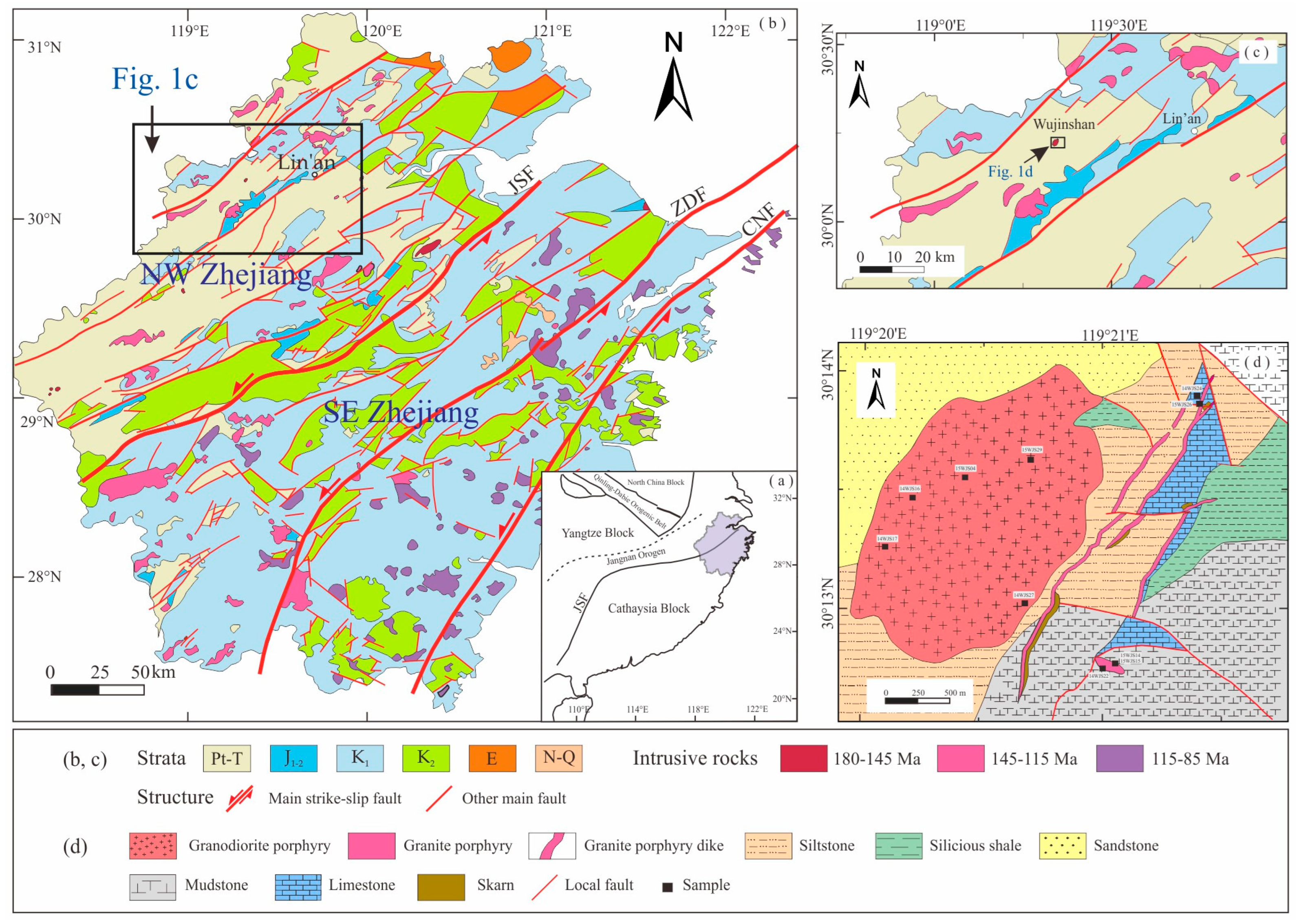
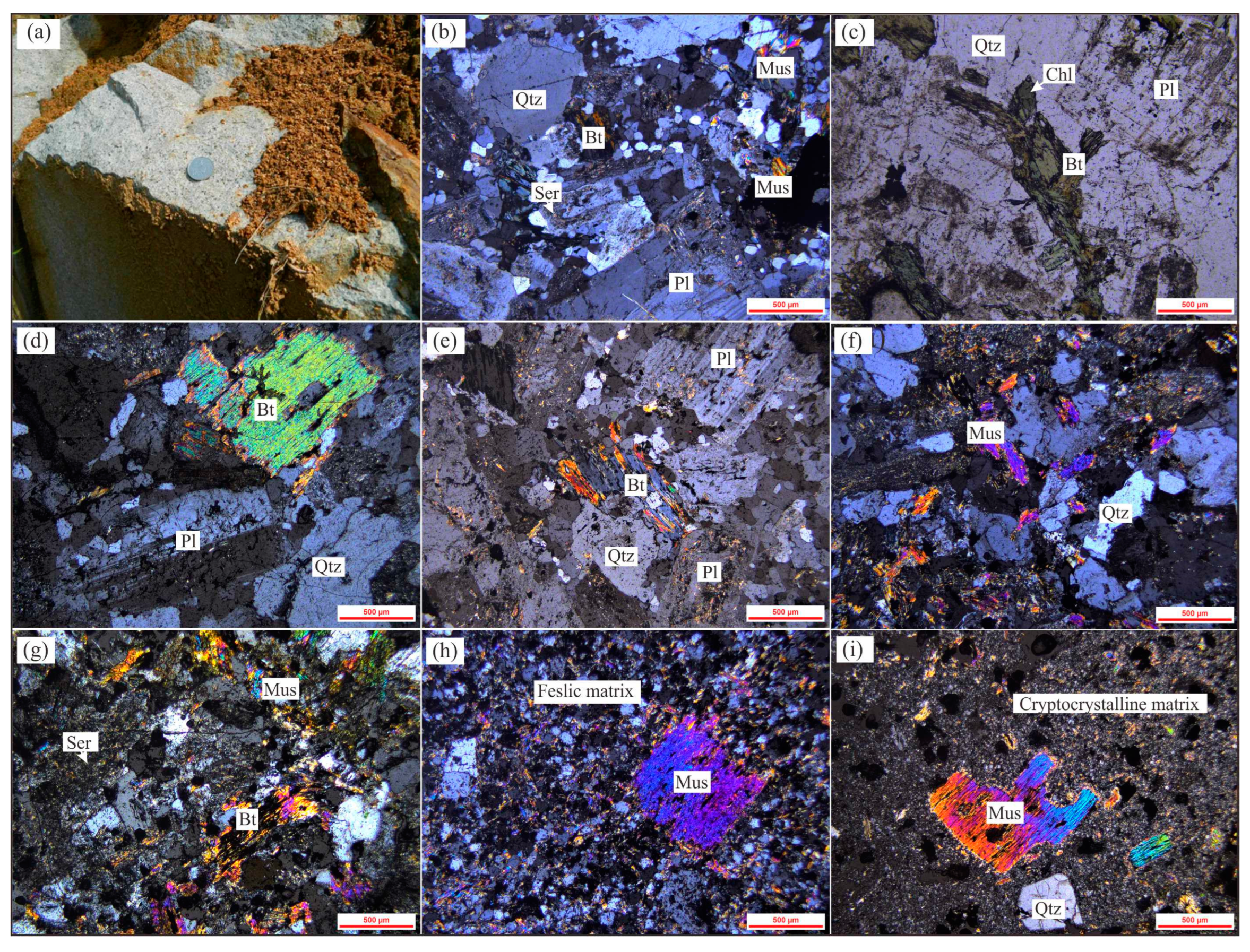
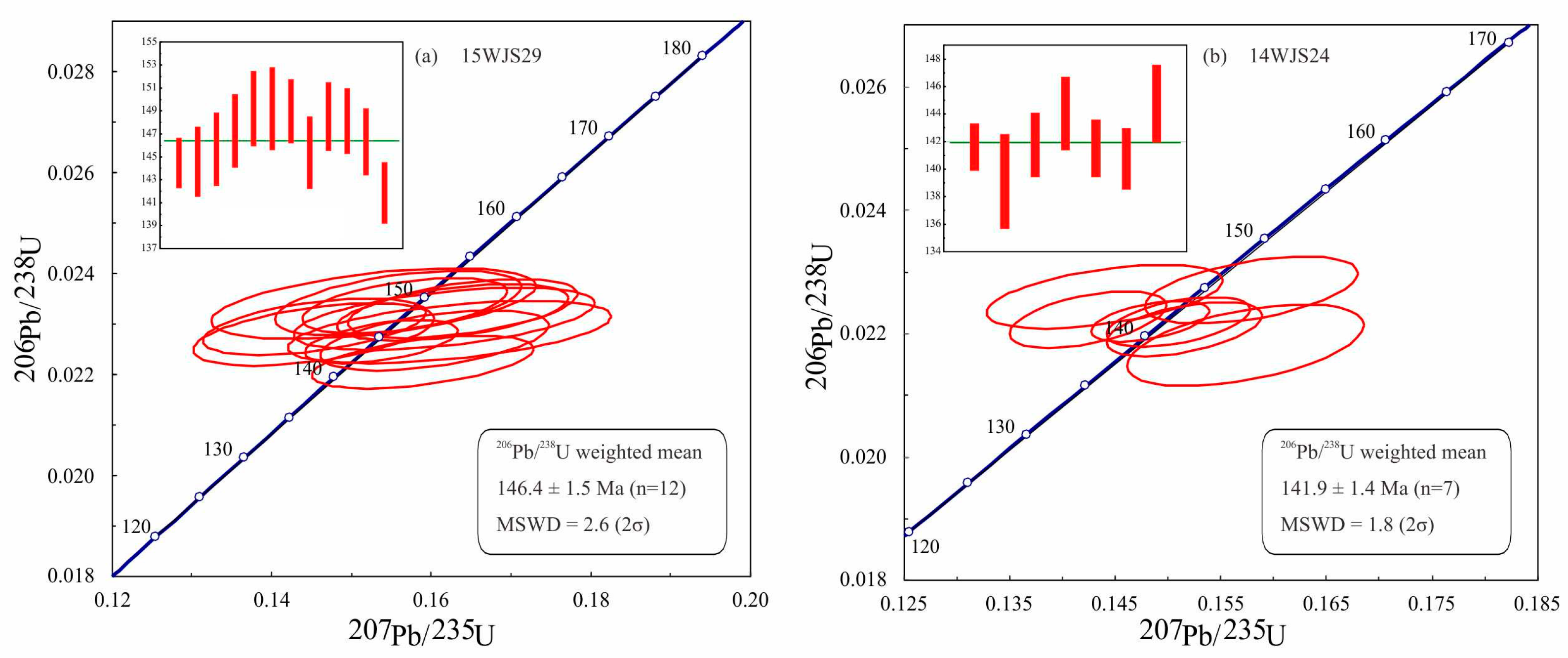
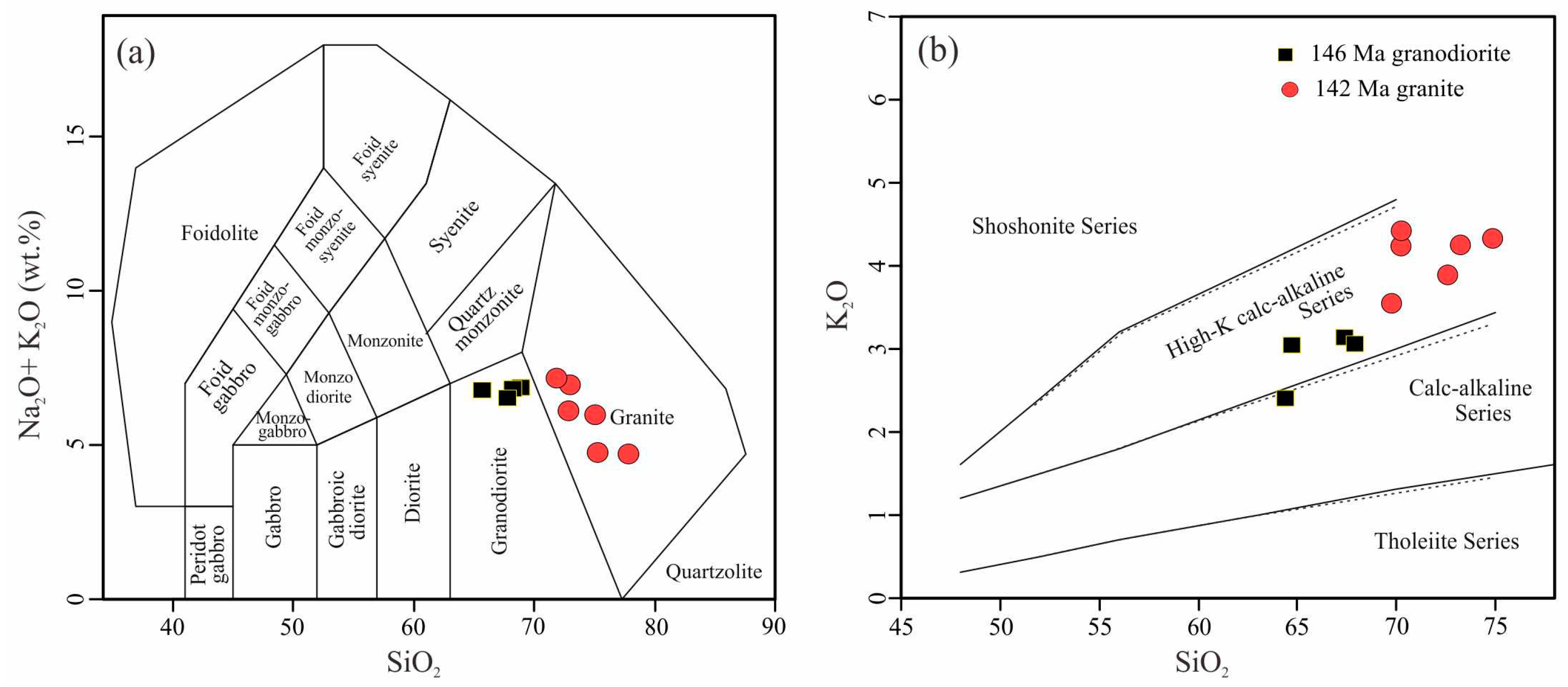



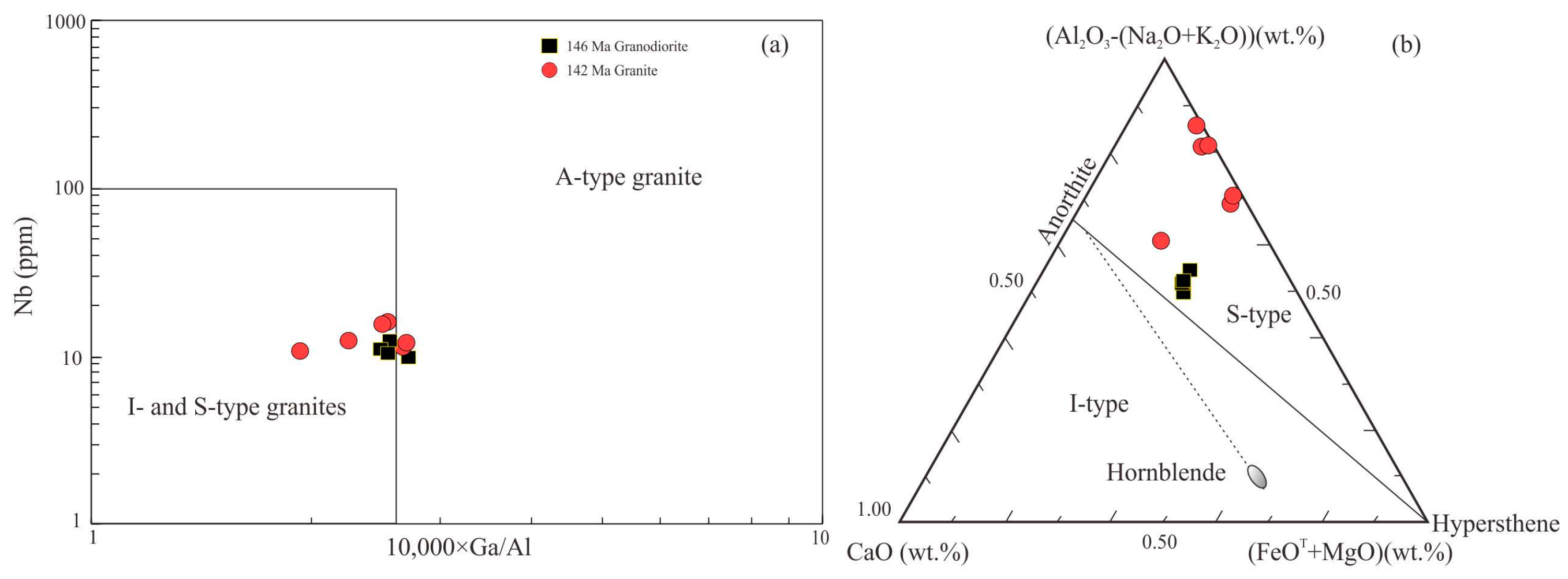
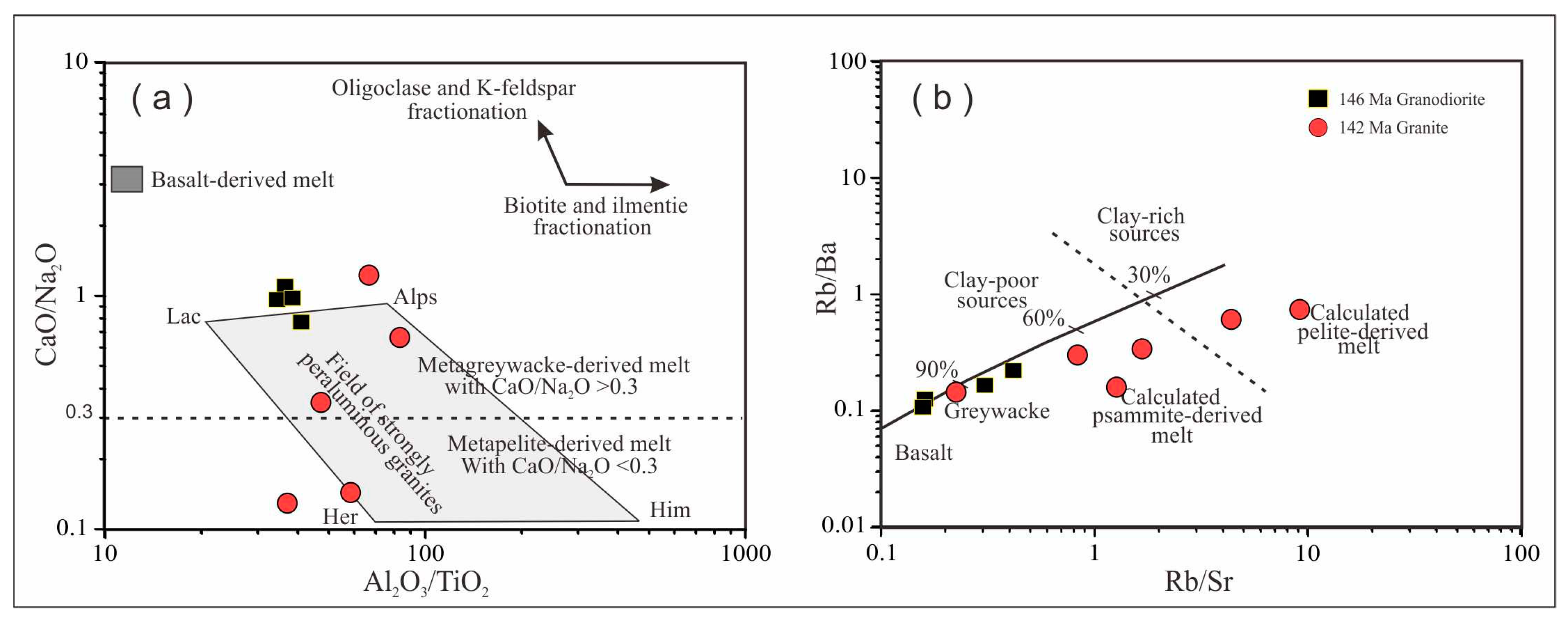
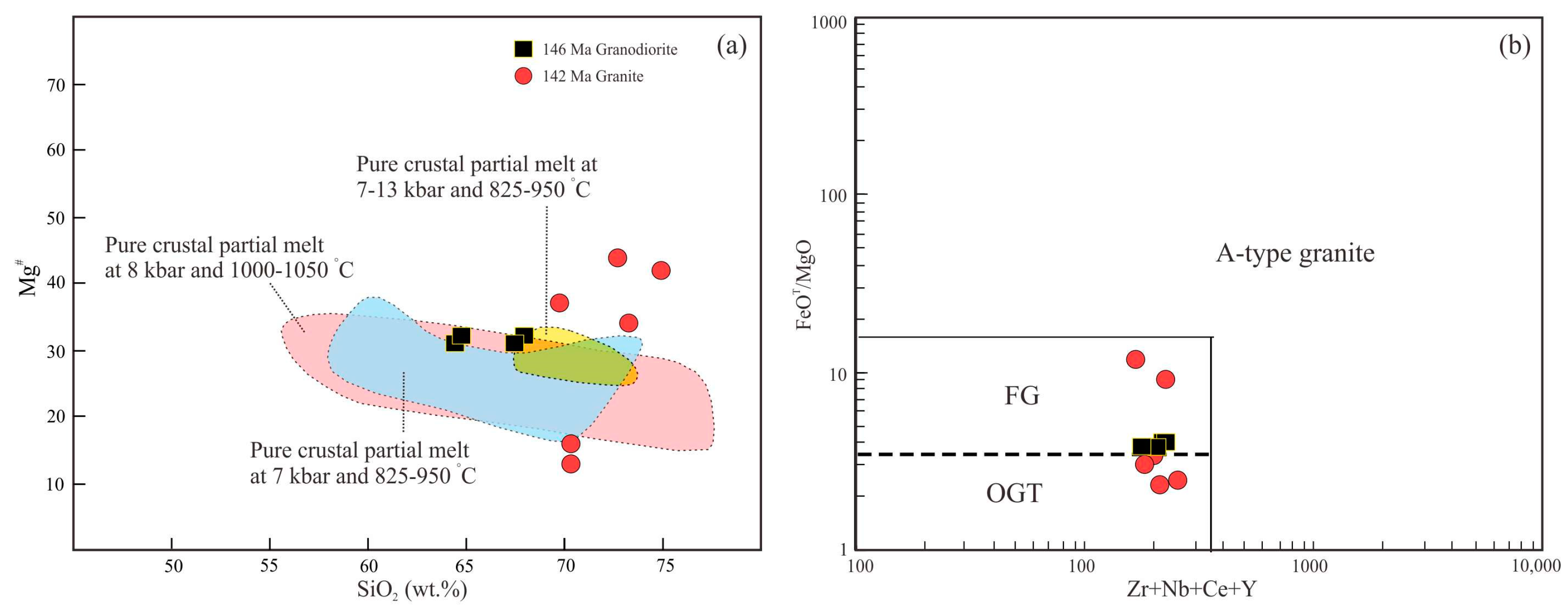


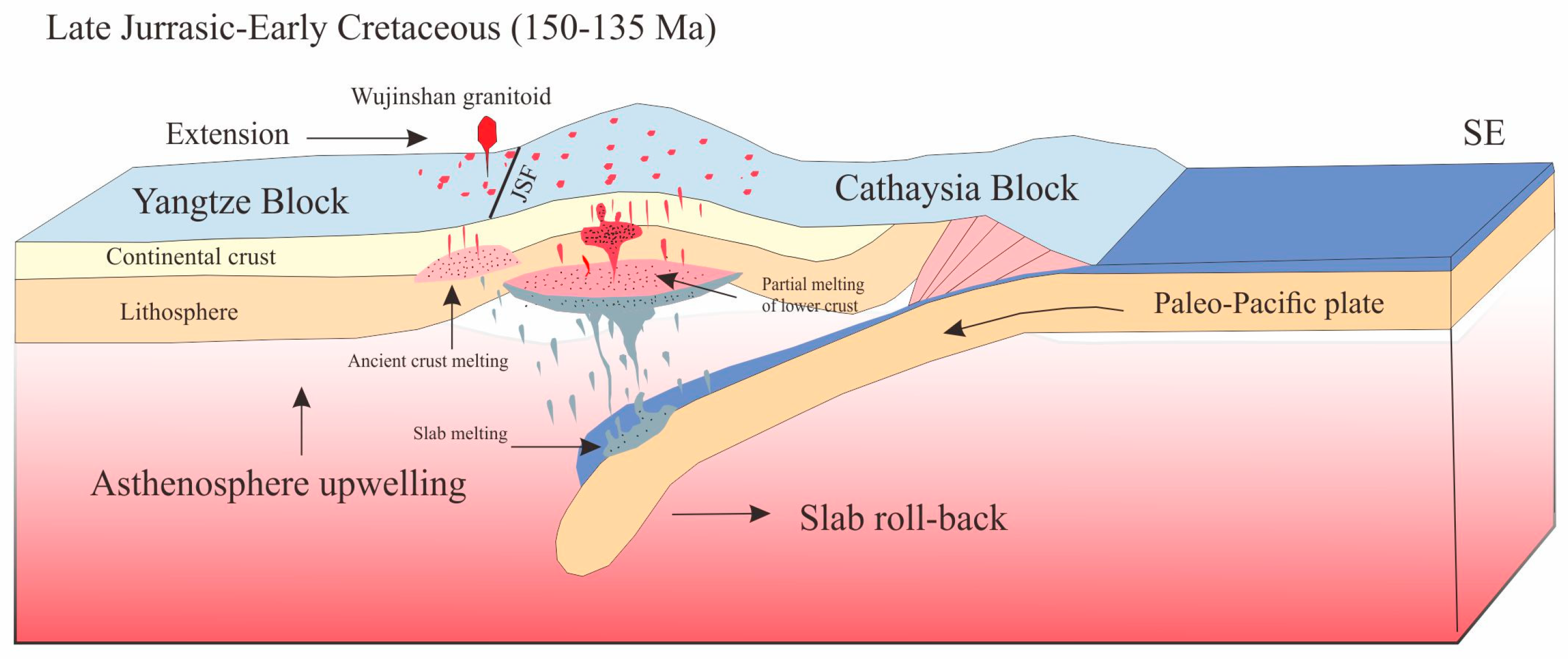

| Samples | Contents (ppm) | Th/U | Isotopic Ratios | Age (Ma) | ||||||||||||
|---|---|---|---|---|---|---|---|---|---|---|---|---|---|---|---|---|
| Pb | Th | U | 206Pb/238U | 1σ | 207Pb/235U | 1σ | 207Pb/206Pb | 1σ | 206Pb/238U | 1σ | 207Pb/235U | 1σ | 207Pb/206Pb | 1σ | ||
| 15WJS29 | ||||||||||||||||
| 3 | 89.0 | 384 | 2402 | 0.16 | 0.0227 | 0.0003 | 0.1538 | 0.0079 | 0.0496 | 0.0027 | 145 | 2.2 | 145 | 6.9 | 176 | 128 |
| 4 | 52.4 | 332 | 732 | 0.45 | 0.0227 | 0.0005 | 0.1604 | 0.0117 | 0.0552 | 0.0050 | 145 | 3.1 | 151 | 10.3 | 417 | 199 |
| 5 | 36.7 | 279 | 640 | 0.44 | 0.0229 | 0.0005 | 0.1623 | 0.0166 | 0.0504 | 0.0056 | 146 | 3.2 | 153 | 14.5 | 217 | 237 |
| 6 | 78 | 499 | 867 | 0.57 | 0.0231 | 0.0005 | 0.1616 | 0.0154 | 0.0534 | 0.0057 | 147 | 3.2 | 152 | 13.5 | 343 | 246 |
| 7 | 49.9 | 323 | 596 | 0.54 | 0.0234 | 0.0005 | 0.1558 | 0.0126 | 0.0522 | 0.0050 | 149 | 3.3 | 147 | 11.1 | 300 | 220 |
| 8 | 62.0 | 395 | 898 | 0.44 | 0.0234 | 0.0006 | 0.1528 | 0.0166 | 0.0507 | 0.0061 | 149 | 3.6 | 144 | 14.6 | 228 | 256 |
| 9 | 78 | 524 | 1003 | 0.52 | 0.0234 | 0.0004 | 0.1567 | 0.0105 | 0.0508 | 0.0040 | 149 | 2.8 | 148 | 9.2 | 232 | 216 |
| 10 | 67.5 | 418 | 835 | 0.50 | 0.0240 | 0.0005 | 0.1625 | 0.0113 | 0.0514 | 0.0045 | 153 | 2.9 | 153 | 9.9 | 257 | 200 |
| 11 | 52.9 | 305 | 690 | 0.44 | 0.0228 | 0.0005 | 0.1453 | 0.0123 | 0.0479 | 0.0048 | 145 | 3.2 | 138 | 10.9 | 100 | 222 |
| 12 | 39.5 | 236 | 609 | 0.39 | 0.0242 | 0.0006 | 0.1713 | 0.0140 | 0.0562 | 0.0063 | 154 | 3.8 | 161 | 12.1 | 461 | 255 |
| 13 | 49.4 | 307 | 647 | 0.47 | 0.0238 | 0.0005 | 0.1634 | 0.0113 | 0.0527 | 0.0048 | 151 | 3.3 | 154 | 9.9 | 317 | 212 |
| 16 | 82 | 518 | 865 | 0.60 | 0.0233 | 0.0005 | 0.1639 | 0.0118 | 0.0534 | 0.0044 | 149 | 3.0 | 154 | 10.3 | 346 | 189 |
| 17 | 76 | 486 | 893 | 0.54 | 0.0232 | 0.0005 | 0.1626 | 0.0119 | 0.0524 | 0.0043 | 148 | 2.9 | 153 | 10.4 | 302 | 191 |
| 18 | 80 | 531 | 932 | 0.57 | 0.0230 | 0.0005 | 0.1453 | 0.0114 | 0.0474 | 0.0040 | 146 | 2.9 | 138 | 10.1 | 77.9 | 180 |
| 19 | 62.7 | 394 | 916 | 0.43 | 0.0223 | 0.0004 | 0.1589 | 0.0113 | 0.0524 | 0.0041 | 142 | 2.7 | 150 | 9.9 | 302 | 184 |
| 20 | 52.7 | 273 | 437 | 0.63 | 0.0248 | 0.0007 | 0.2954 | 0.0300 | 0.0926 | 0.0096 | 158 | 4.6 | 263 | 23.5 | 1480 | 194 |
| Inherited zircons | ||||||||||||||||
| 1 | 509 | 708 | 1160 | 0.61 | 0.0811 | 0.0014 | 0.6523 | 0.0331 | 0.0577 | 0.0031 | 502 | 8.4 | 510 | 20.4 | 517 | 117 |
| 2 | 467 | 692 | 475 | 1.46 | 0.0855 | 0.0017 | 0.8211 | 0.0537 | 0.0681 | 0.0047 | 529 | 9.9 | 609 | 29.9 | 872 | 144 |
| 14 | 160 | 330 | 663 | 0.50 | 0.0622 | 0.0014 | 0.5011 | 0.0290 | 0.0577 | 0.0034 | 389 | 8.4 | 412 | 19.6 | 520 | 130 |
| 15 | 254 | 276 | 624 | 0.44 | 0.1300 | 0.0021 | 1.0602 | 0.0476 | 0.0592 | 0.0028 | 788 | 12.1 | 734 | 23.5 | 576 | 99.1 |
| 14WJS24 | ||||||||||||||||
| 1 | 11.3 | 196.1 | 403.3 | 0.49 | 0.0222 | 0.0003 | 0.1483 | 0.0046 | 0.0491 | 0.0016 | 142 | 1.7 | 140 | 4.0 | 154 | 79.6 |
| 2 | 5.7 | 102.6 | 223.4 | 0.46 | 0.0220 | 0.0003 | 0.1681 | 0.0070 | 0.0564 | 0.0025 | 140 | 2.0 | 158 | 6.1 | 478 | 100 |
| 4 | 5.4 | 82.6 | 222.1 | 0.37 | 0.0218 | 0.0005 | 0.1573 | 0.0092 | 0.0539 | 0.0032 | 139 | 3.4 | 148 | 8.0 | 369 | 132.4 |
| 5 | 7.2 | 109.9 | 290.5 | 0.38 | 0.0222 | 0.0004 | 0.1424 | 0.0060 | 0.0473 | 0.0022 | 142 | 2.4 | 135 | 5.4 | 65 | 107.4 |
| 6 | 4.3 | 66.9 | 168.7 | 0.40 | 0.0226 | 0.0004 | 0.1440 | 0.0091 | 0.0476 | 0.0034 | 144 | 2.7 | 137 | 8.1 | 80 | 159.2 |
| 7 | 7.4 | 91.0 | 268.8 | 0.34 | 0.0218 | 0.0005 | 0.1882 | 0.0142 | 0.0630 | 0.0045 | 139 | 3.2 | 175 | 12.1 | 709 | 153.7 |
| 9 | 11.0 | 205.9 | 418.9 | 0.49 | 0.0222 | 0.0003 | 0.1509 | 0.0056 | 0.0500 | 0.0019 | 142 | 2.1 | 143 | 4.9 | 195 | 88.9 |
| 10 | 9.2 | 183.6 | 360.5 | 0.51 | 0.0221 | 0.0004 | 0.1515 | 0.0060 | 0.0507 | 0.0021 | 141 | 2.2 | 143 | 5.3 | 233 | 94.4 |
| 11 | 8.2 | 79.2 | 226.1 | 0.35 | 0.0217 | 0.0005 | 0.3015 | 0.0254 | 0.0972 | 0.0071 | 138 | 3.2 | 268 | 19.8 | 1572 | 136.9 |
| 12 | 6.7 | 82.6 | 235.2 | 0.35 | 0.0227 | 0.0004 | 0.1579 | 0.0083 | 0.0496 | 0.0029 | 145 | 2.8 | 149 | 7.2 | 176 | 137 |
| Inherited zircon | ||||||||||||||||
| 3 | 7.7 | 62.4 | 54.2 | 1.15 | 0.0755 | 0.0017 | 0.6779 | 0.0342 | 0.0654 | 0.0031 | 469 | 10.4 | 525 | 20.7 | 789 | 100 |
| Sample | 14WJS16 | 14WJS17 | 15WJS04 | 15WJS29 | 14WJS27 | 15WJS26 | 14WJS22 | 14WJS24 | 15WJS14 | 15WJS15 |
|---|---|---|---|---|---|---|---|---|---|---|
| Granodiorite Porphyry | Granite Porphyries | |||||||||
| SiO2 (wt.%) | 64.70 | 64.38 | 67.89 | 67.40 | 73.22 | 69.68 | 70.23 | 72.60 | 74.85 | 70.25 |
| TiO2 | 0.42 | 0.47 | 0.38 | 0.40 | 0.34 | 0.21 | 0.40 | 0.27 | 0.18 | 0.46 |
| Al2O3 | 15.25 | 16.09 | 15.63 | 15.46 | 16.17 | 14.15 | 14.74 | 15.52 | 14.79 | 15.76 |
| Fe2O3 | 4.22 | 4.95 | 3.96 | 4.21 | 2.17 | 2.17 | 3.33 | 1.54 | 1.27 | 3.57 |
| FeOT | 3.80 | 4.45 | 3.57 | 3.78 | 1.95 | 1.95 | 2.99 | 1.39 | 1.14 | 3.21 |
| MnO | 0.06 | 0.06 | 0.05 | 0.07 | 0.01 | 0.03 | 0.08 | 0.02 | 0.02 | 0.08 |
| MgO | 0.99 | 1.10 | 0.92 | 0.93 | 0.57 | 0.65 | 0.33 | 0.60 | 0.46 | 0.28 |
| CaO | 3.48 | 4.07 | 2.86 | 3.49 | 0.13 | 2.75 | 0.32 | 0.27 | 0.12 | 0.19 |
| Na2O | 3.18 | 4.24 | 3.71 | 3.58 | 0.36 | 2.25 | 2.46 | 1.88 | 0.18 | 2.57 |
| K2O | 3.05 | 2.40 | 3.07 | 3.14 | 4.24 | 3.57 | 4.23 | 3.89 | 4.33 | 4.42 |
| P2O5 | 0.17 | 0.21 | 0.16 | 0.17 | 0.09 | 0.12 | 0.17 | 0.14 | 0.02 | 0.17 |
| LOI | 3.65 | 1.64 | 1.25 | 1.20 | 2.84 | 3.88 | 2.34 | 2.06 | 2.38 | 2.07 |
| Total | 100.6 | 99.92 | 101.2 | 101.1 | 100.2 | 100.6 | 99.71 | 98.86 | 98.67 | 99.85 |
| Ga (ppm) | 20.0 | 23.2 | 21.0 | 21.0 | 23.1 | 20.0 | 19.5 | 18.4 | 19.9 | 16.1 |
| Rb | 127 | 76.6 | 72.0 | 116 | 236 | 92.8 | 159 | 168 | 170 | 164 |
| Sr | 303 | 476 | 457 | 379 | 25.8 | 413 | 126 | 100 | 38.9 | 197 |
| Y | 18.8 | 19.1 | 19.2 | 20.1 | 9.61 | 19.6 | 43.6 | 26.9 | 25.4 | 20.9 |
| Zr | 170 | 215 | 198 | 210 | 193 | 178 | 223 | 206 | 255 | 160 |
| Nb | 11.2 | 9.76 | 10.3 | 12.4 | 12.0 | 11.3 | 15.7 | 12.5 | 16.0 | 10.7 |
| Cs | 6.21 | 3.84 | 5.18 | 4.03 | 17.26 | 3.93 | 7.14 | 14.84 | 8.84 | 16.18 |
| Ba | 582 | 618 | 683 | 713 | 327 | 654 | 7111 | 505 | 285 | 555 |
| La | 25.9 | 26.0 | 34.0 | 31.5 | 36.5 | 25.4 | 49.1 | 42.8 | 46.6 | 28.1 |
| Ce | 53.3 | 51.6 | 65.1 | 61.8 | 62.7 | 51.2 | 86.5 | 82.7 | 90.6 | 56.8 |
| Pr | 6.67 | 6.78 | 8.12 | 7.76 | 8.65 | 6.49 | 11.7 | 10.3 | 10.9 | 6.76 |
| Nd | 25.2 | 25.4 | 29.6 | 28.0 | 30.1 | 24.5 | 42.2 | 37.0 | 38.0 | 23.9 |
| Sm | 4.97 | 4.97 | 5.43 | 5.31 | 5.12 | 4.96 | 8.43 | 6.35 | 6.92 | 4.30 |
| Eu | 1.24 | 1.44 | 1.45 | 1.32 | 1.32 | 1.27 | 2.26 | 1.11 | 1.29 | 0.96 |
| Gd | 4.65 | 4.73 | 5.15 | 5.10 | 4.12 | 4.74 | 8.54 | 5.87 | 6.36 | 3.95 |
| Tb | 0.73 | 0.74 | 0.82 | 0.78 | 0.63 | 0.76 | 1.36 | 0.91 | 0.94 | 0.64 |
| Dy | 3.47 | 3.60 | 3.74 | 3.76 | 2.20 | 3.67 | 7.07 | 4.47 | 4.78 | 3.35 |
| Ho | 0.72 | 0.73 | 0.81 | 0.77 | 0.53 | 0.77 | 1.51 | 1.02 | 0.98 | 0.77 |
| Er | 1.70 | 1.78 | 1.77 | 1.84 | 1.01 | 1.79 | 3.87 | 2.58 | 2.56 | 2.07 |
| Yb | 1.56 | 1.62 | 1.62 | 1.74 | 0.91 | 1.65 | 3.69 | 2.82 | 2.50 | 2.33 |
| Lu | 0.30 | 0.31 | 0.35 | 0.33 | 0.26 | 0.32 | 0.67 | 0.54 | 0.44 | 0.43 |
| Hf | 4.84 | 5.73 | 5.20 | 5.71 | 5.28 | 4.98 | 6.07 | 5.51 | 6.68 | 4.53 |
| Ta | 0.94 | 0.80 | 0.79 | 1.06 | 1.05 | 0.95 | 1.42 | 1.00 | 1.33 | 0.89 |
| Th | 9.07 | 8.20 | 8.66 | 10.4 | 11.1 | 8.89 | 18.1 | 9.97 | 17.3 | 8.58 |
| U | 2.85 | 2.45 | 2.20 | 2.90 | 2.82 | 2.65 | 4.44 | 2.71 | 4.28 | 2.73 |
| A/CNK | 1.30 | 1.21 | 1.30 | 1.24 | 3.05 | 1.40 | 1.65 | 2.06 | 2.89 | 1.72 |
| σ | 1.79 | 2.06 | 1.85 | 1.85 | 0.70 | 1.27 | 1.64 | 1.12 | 0.64 | 1.79 |
| Mg # | 0.32 | 0.31 | 0.32 | 0.31 | 0.34 | 0.37 | 0.16 | 0.44 | 0.42 | 0.13 |
| ΣREE | 150 | 149 | 177 | 171 | 164 | 147 | 271 | 226 | 239 | 156 |
| Eu/Eu* | 4.81 | 4.85 | 5.28 | 5.21 | 4.59 | 4.85 | 8.48 | 6.11 | 6.64 | 4.12 |
| Zr+Nb+Ce+Y | 179 | 226 | 207 | 219 | 197 | 184 | 227 | 209 | 258 | 164 |
| 87Rb/86Sr | 0.465900 | 0.886500 | ||||||||
| 87Sr/86Sr | 0.708487 | 0.710408 | ||||||||
| ±2σ | 0.000006 | 0.000006 | ||||||||
| (87Sr/86Sr)i | 0.707500 | 0.708600 | ||||||||
| 147Sm/144Nd | 0.009056 | 0.007136 | ||||||||
| 143Nd/144Nd | 0.512300 | 0.512300 | ||||||||
| ±2σ | 0.000005 | 0.000005 | ||||||||
| εNd(t) | −3.5 | −2.9 | ||||||||
| TDM1 (Ga) | 0.58 | 0.58 | ||||||||
| TDM2 (Ga) | 1.21 | 1.17 | ||||||||
Disclaimer/Publisher’s Note: The statements, opinions and data contained in all publications are solely those of the individual author(s) and contributor(s) and not of MDPI and/or the editor(s). MDPI and/or the editor(s) disclaim responsibility for any injury to people or property resulting from any ideas, methods, instructions or products referred to in the content. |
© 2023 by the authors. Licensee MDPI, Basel, Switzerland. This article is an open access article distributed under the terms and conditions of the Creative Commons Attribution (CC BY) license (https://creativecommons.org/licenses/by/4.0/).
Share and Cite
Siddique, U.; Zeng, Z.; Zhang, F.; Farhan, M.; Wang, C.; Xia, Q.; Gao, X.; Zhang, K.; Gao, Q.; Li, Z. Zircon U-Pb Ages, Petrogenesis, and Tectono-Magmatic Evolution of Late Jurassic–Early Cretaceous S-Type Granitoid in Wujinshan Area of Northwestern Zhejiang, South China. Minerals 2023, 13, 1190. https://doi.org/10.3390/min13091190
Siddique U, Zeng Z, Zhang F, Farhan M, Wang C, Xia Q, Gao X, Zhang K, Gao Q, Li Z. Zircon U-Pb Ages, Petrogenesis, and Tectono-Magmatic Evolution of Late Jurassic–Early Cretaceous S-Type Granitoid in Wujinshan Area of Northwestern Zhejiang, South China. Minerals. 2023; 13(9):1190. https://doi.org/10.3390/min13091190
Chicago/Turabian StyleSiddique, Uzair, Zhijie Zeng, Fangjun Zhang, Muhammad Farhan, Chengliang Wang, Qijun Xia, Xiang Gao, Kunlun Zhang, Qin Gao, and Zilong Li. 2023. "Zircon U-Pb Ages, Petrogenesis, and Tectono-Magmatic Evolution of Late Jurassic–Early Cretaceous S-Type Granitoid in Wujinshan Area of Northwestern Zhejiang, South China" Minerals 13, no. 9: 1190. https://doi.org/10.3390/min13091190








